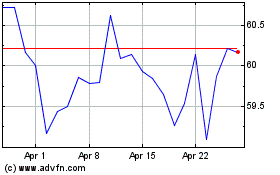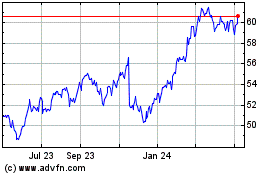By Jennifer Smith and Kimberly Chin
Amazon.com Inc. will pay its employees to quit and help them
start their own local package-delivery businesses, as the
e-commerce giant competes for delivery drivers in the tightest U.S.
labor market in 50 years.
Transportation operators, from long-haul truckers to retail
chains like Walmart Inc. to startups such as Deliv, are
increasingly competing for people to help them carry the millions
of packages that are moving each day around the country. Demand for
so-called last-mile delivery is booming as more Americans shop
online.
Amazon has been expanding its own logistics and delivery
operations, although it still relies heavily on the U.S. Postal
Service and others to take most of its orders to people's homes. In
an effort to handle more of those packages itself, the company
announced a program last June that invited entrepreneurs to form
local delivery operations with dozens of drivers in leased vans
bearing the Amazon logo. So far, about 200 such firms have been
created, Amazon said.
On Monday, seeking to create several hundred more, Amazon said
it would give its existing employees as much as $10,000 each for
startup costs as well as the equivalent of three months of gross
salary if they start their own delivery businesses. Even if 500
employees took the offer, it would be a modest investment for the
company, which has about 650,000 full- and part-time workers around
the globe.
The new incentives suggest the e-commerce giant is "finding they
need to add people faster, and to do so they need to provide
additional incentives to come on board," said Satish Jindel,
president of ShipMatrix Inc., which analyzes package-shipping
data.
As the program grows, Mr. Jindel said, Amazon is likely to cut
back on the amount of last-mile business it gives to the other big
competitors, directing fewer packages to United Parcel Service
Inc., FedEx Corp. and the Postal Service. He estimates providers in
Amazon's program could handle an estimated half of the company's
last-mile volumes by 2022.
A spokeswoman for Amazon said "customer demand continues to
grow," adding, "I wouldn't think about it as one or the other, it's
really more like all of the above."
FedEx and UPS have consistently played down the threat of Amazon
delivering more packages itself, saying the online giant still
needs to use the established delivery giants to ship many of its
packages. FedEx earlier this year said Amazon made up 1.3% of its
revenue in 2018, an unusual disclosure.
Targeting Amazon employees to help handle those deliveries makes
sense, Mr. Jindel said, because they already have been vetted and
have a record with the company.
The employee incentive program could indicate Amazon isn't
recruiting as many small partners as it expected, said Cathy
Roberson, an analyst with Logistics Trends & Insights LLC.
"What kind of response are they not getting from the original
delivery-service partner program?" said Ms. Roberson.
The spokeswoman for Amazon said tens of thousands of people have
applied to the program since its launch last year, and that the
incentives are part of "a long history of providing help to our
employees."
The employee incentive program was in the works before Amazon
announced it was moving to one-day delivery for Prime members, she
said, adding that "this will be part of our efforts to continue to
speed up delivery to our customers."
As it ramps up recruitment, Amazon is building out a network of
delivery stations to help speed parcels to consumers. Packages are
sorted by route and then handed off to local delivery partners,
said Marc Wulfraat, president of supply-chain consulting firm MWPVL
International Inc.
The company is expanding those stations beyond the big cities
and moving into smaller markets such as Gary, Ind., and Youngstown,
Ohio. "They've already conquered all the big cities," said Mr.
Wulfraat, whose firm estimates Amazon already has about 115 such
locations in metropolitan areas, and has about 10 more in the
works.
Employees who opt to start a new delivery business would have to
quit Amazon, the company said, but it would provide them with a
consistent delivery flow from the company, access to its delivery
technology, Amazon-branded vans for delivery, as well as branded
uniforms and insurance.
The company requires candidates to have liquid assets of $30,000
to ensure they can cover startup costs and living expenses,
according to answers to frequently asked questions about the
program on Amazon's website. That number will be scaled back for
employees participating in the incentive program "given that we are
helping them cover the startup costs," the spokeswoman said.
"Now we have a path for those associates with an appetite for
opportunities to own their own businesses," said Dave Clark,
Amazon's senior vice president of world-wide operations, in
prepared remarks.
Write to Jennifer Smith at jennifer.smith@wsj.com and Kimberly
Chin at kimberly.chin@wsj.com
(END) Dow Jones Newswires
May 13, 2019 12:49 ET (16:49 GMT)
Copyright (c) 2019 Dow Jones & Company, Inc.
Walmart (NYSE:WMT)
Historical Stock Chart
From Mar 2024 to Apr 2024

Walmart (NYSE:WMT)
Historical Stock Chart
From Apr 2023 to Apr 2024
